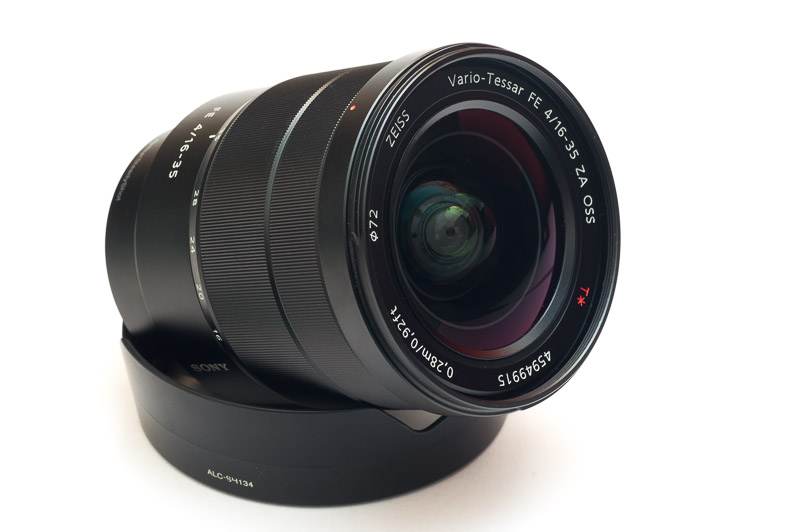
In-Depth Review of the Sony FE 16-35mm f4 ZA OSS T* based on two years of experience and technical analysis. Many full resolution images included.
Sample Images
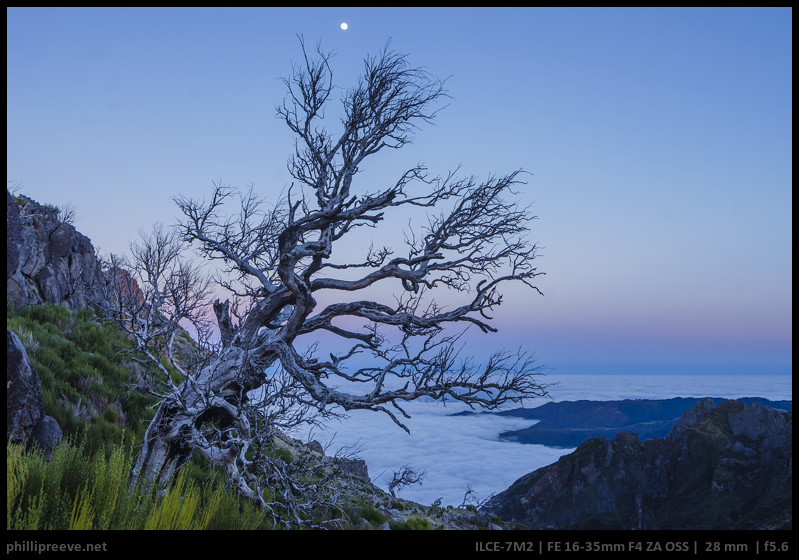

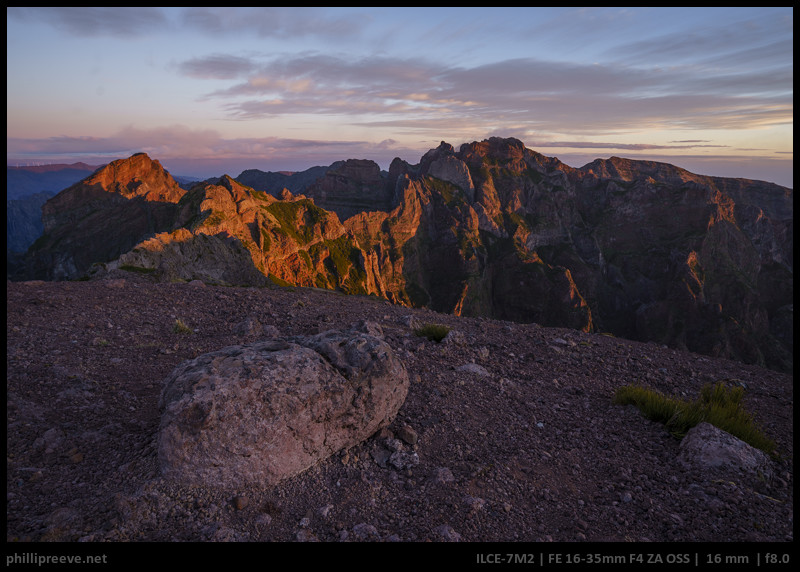
Specifications
| Diameter | 78 mm |
| Length | 98.5 mm |
| Filter Thread | 72 mm |
| Weight | 518 g |
| Max. Magnification | 0.19 |
| Close Focusing Distance from the sensor | 28 cm |
| Number of aperture blades | 7 (circular) |
| Elements/ Groups | 12/10 |
Disclosure
In 2015 Sony loaned me a copy free of charge for three weeks. Shortly after that I bought another copy from Amazon and still use it a lot.
Built Quality
This Sony FE 16-35mm f/4 ZA OSS T* is built well and feels quite solid.
The outer barrel is made from metal, as is is the filter thread.
The inner barrel is made from plastics and shows no play.
The zoom-ring allows for very precise zooming with a very even resistance and zero play.
The focusing-ring has a smooth feel to it and it has zero play as well.
Both rings are made from textured metal which easily gathers dirt, but it is easy to clean as well.
The lens hood is rather heavy and has a nice feel to it, it needs a healthy amount of force to remove it.
Unlike L-lenses from Canon the lens has no gasket around the lens mount, so weather resistance will be limited.
Autofocus
I use a Sony Alpha 7 and a7ii, results will differ with other E-mount cameras.
In a normal environment the SEL1635f4 focuses very quick and precise.
In a darker environment, like a normally lit room at night (f/4, 1/50 Sek., ISO 3200) the AF is slower but still usable for people photography.
If it gets even darker it takes more than one second until the lens is focused but it still locks focus.
After two years the AF has proven it’s reliability to my in about any scenario from weddings over environmental portraits to landscape and I found it very reliable. Whenever there was a limitation the camera was the limiting factor.
Manual Focus
As mentioned before, the focusing ring feels nice nice, what I don’t like too much is the focus by wire implementation.
One problem here is that it matters how fast you turn the focusing ring, if I turn it by 20 degrees very fast the focus changes from 28cm to infinity. If I turn it slowly it takes more than 360 degrees (one full turn) to change focus from the close focusing distance to infinity.
In theory this sounds like a great idea because focusing should be either super precise or very quick, depending on what you need. But so far I have failed to get to a point were my I am able to use this subconciously, and I have used manual focus with this lens and the FE 2/28 a lot.
The other problem is that there is a small lag between the moment when you turn the focusing ring and when the lens reacts.
I am used to manual lenses where the focusing ring is coupled directly to the focusing helicoid and I am faster and as precise with them. So manual focus works okay but it isn’t very enjoyable (says a hardcore manual lens user).
Size,Weight and Handling
Compared to CaNikon’s 4/16-35 lenses the lens is quite a bit smaller and lighter. None the less at over 500 grams and with a length of nearly 10 centimeters it is still a substantial lens. It also has a very wide diameter of 78mm. My smaller bag normally fit’s three lenses but I can only fit one other lens into it if I use the Sony.
I find the lens to be not very well balanced on my Sony Alpha 7, it is a bit front heavy and I feel a constant need to support it with my other hand. I usually have an L-bracket attached to my a7 and with that the lens is quite well balanced.
The FE 4/16-35 is shortest when zoomed to 35mm and it extends by about 15mm when zoomed to 16mm. It does not extend when focused, nor does the front of the lens rotate.

The Image Stabilizer
The leans features an image stabilizer. I tested the efficiency at 28mm and found that it made a difference of about 3 stops.
I found the stabilizer very useful for my photography, it gave me more creative freedom in situations were I couldn’t bring a tripod or I could leave the tripod at home. Take this picture for example:
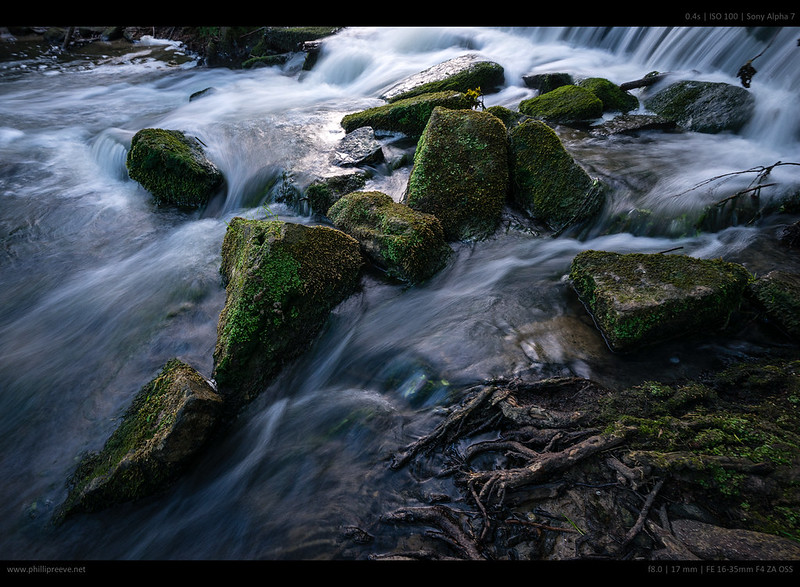
Even though I had no tripod with me the stabilizer allowed me to expose long enough for the water to blur quite nicely plus it would have been hard to set up a tripod in this place. I should mention, that this is the best from 5 images and it is not as sharp as it would have been had I used a tripod.
Here is another example with the same shutter speed of 0.4s but at 32mm. I think it wouldn’t have been significantly sharper if I had used a tripod.
32mm | 0.4s | handheld
Optical performance
Sharpness
From f/4 the SEL1635f4z shows an excellent performance in the center and midframe area while the corners are a bit hazy.
Stopped down to f/8 the corners are good to very good but some astigmatism remains.
Field curvature is quite pronounced: When the lens is focused at infinity, details in the corners will be sharpest at a distance of 3 or 4 meters.
Very similar to 16mm: Great in the center corners are good and benefit from stopping down to f/8.
Again: Very similar to 16mm: Great in the center corners are good and benefit from stopping down to f/8.
I think the corner sharpness at f/4 is a little lower than at other focal lengths but by f/8 they are very good. The center and midframe region is excellent from f/4.
All in all this is a very good performance with excellent sharpness in the center from f/4 at any focal lengths and very good across the frame sharpness at f/8.
Vignetting
At 16mm quite noticeable at f/4, better by f/5.6 and more or less gone by f/8. The more you zoom in, the less pronounced it will be.
Distortion
The SEL1635z shows a noticeable amount of barrel distortion at 16mm, which is nearly gone by 20mm. It then changes to moderate (sample at 28mm) pincushion distortion which is most extreme at 35mm.
This needs to be corrected for architecture photography but for most subjects it is a no-issue.
Flare resistance and sun-stars
The flare resistance differs a lot with focal lenght and position of of the light source in the frame.
Sometimes it produces no flares with a bright light source in the image:
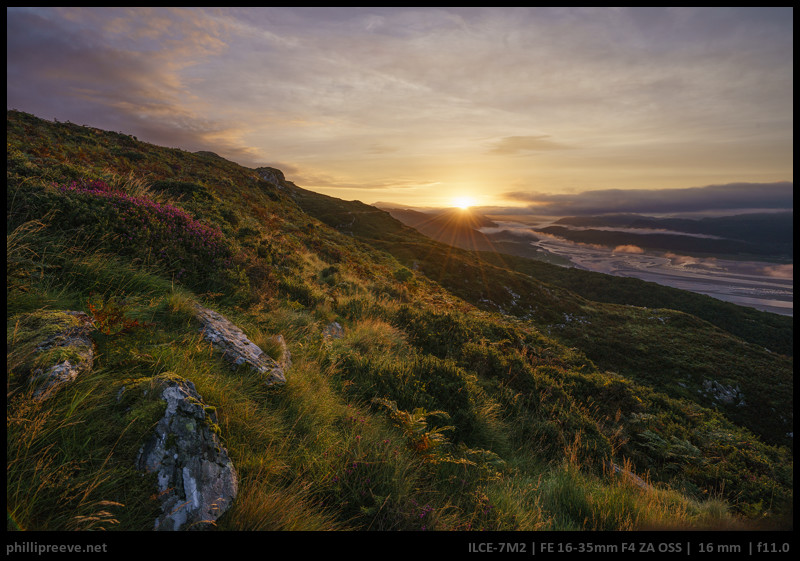
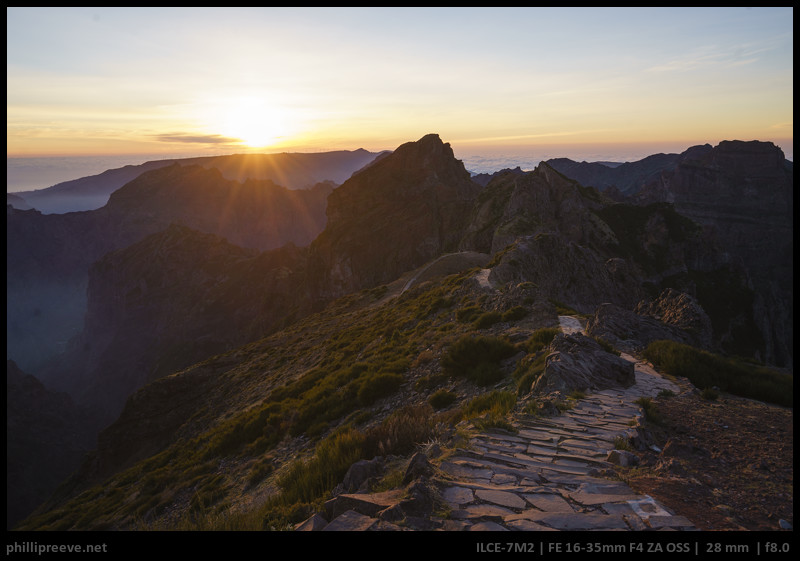
Sometimes some ghosting but very little veiling flare are visible:
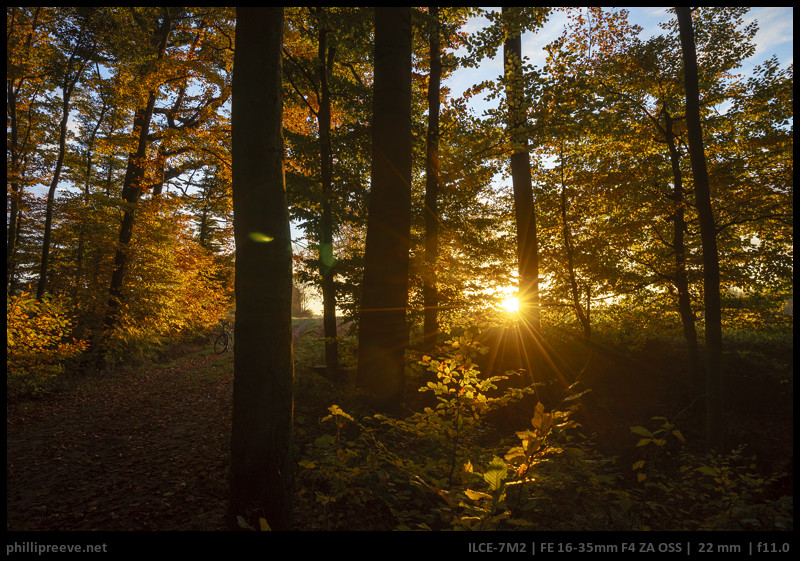

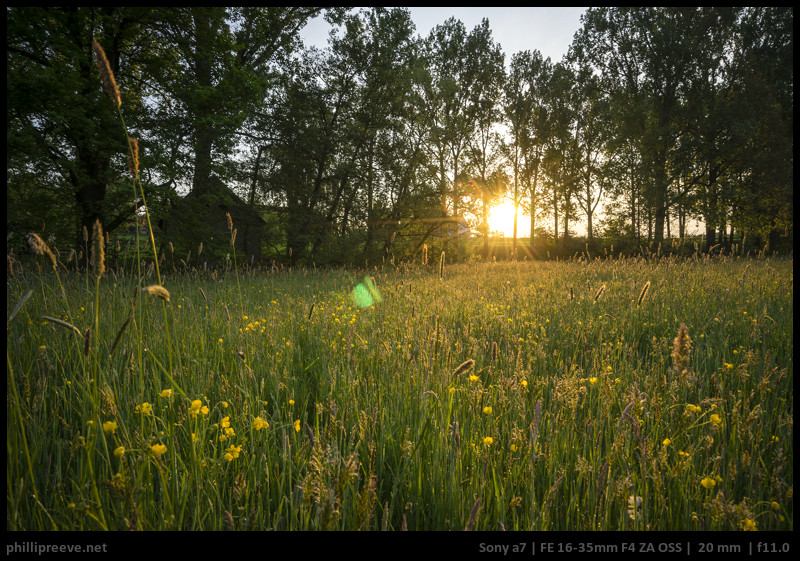
But I also lost a few images because of flare issues in rather demanding scenarios:
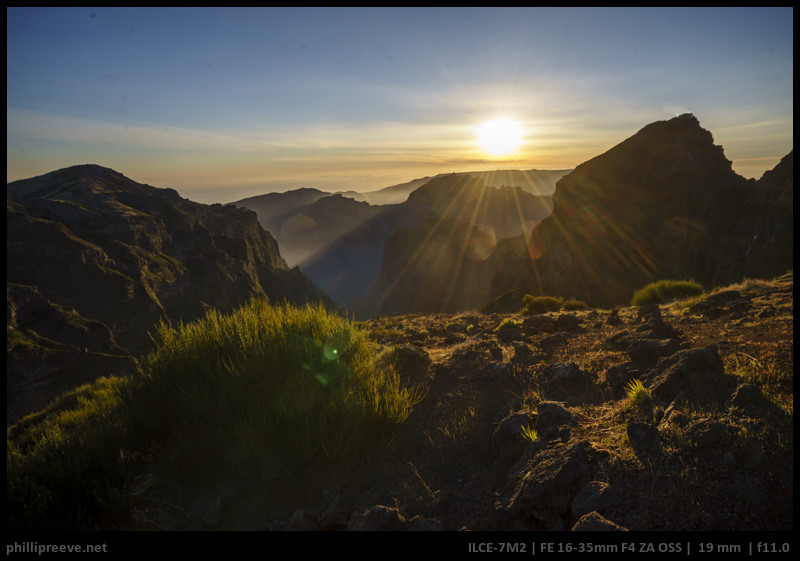
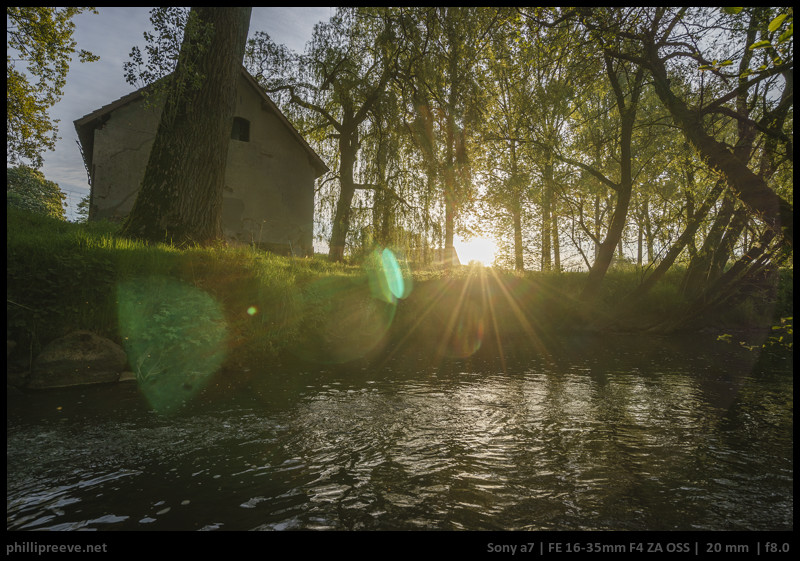
The Sony FE 16-35mm f4 has unusual sun-stars. Other lenses with 7 aperture blades show 14-pointed sun-stars but the Sony shows 28-pointed sun-stars. If you like them will depend on taste, personally I prefer 10-pointed sun-stars but still like the Sony’s sun-stars. Bastian and Yannik both disagree with me on this topic.
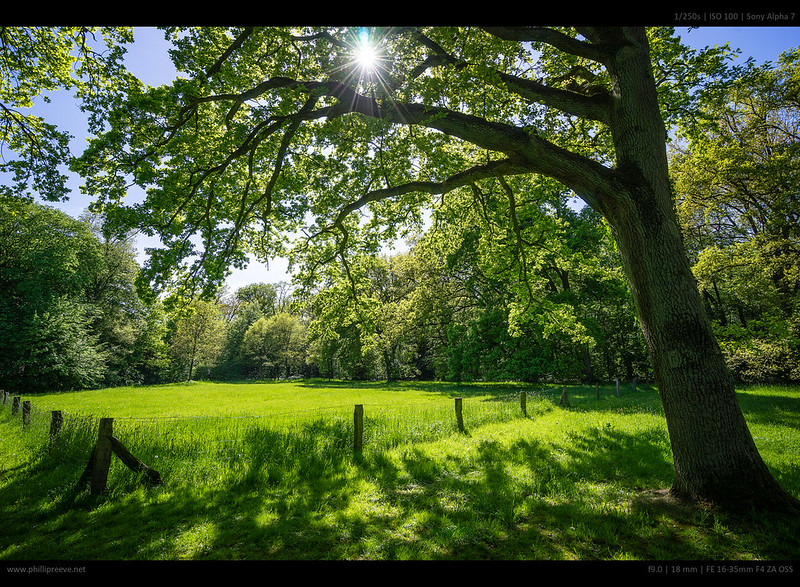
Bokeh
The amount of background blur you can get out of theFE 4/16-35 is of course limited by it’s moderate speed and short focal length. The bokeh is on the nervous side and I found it to be some times detrimental to the image.
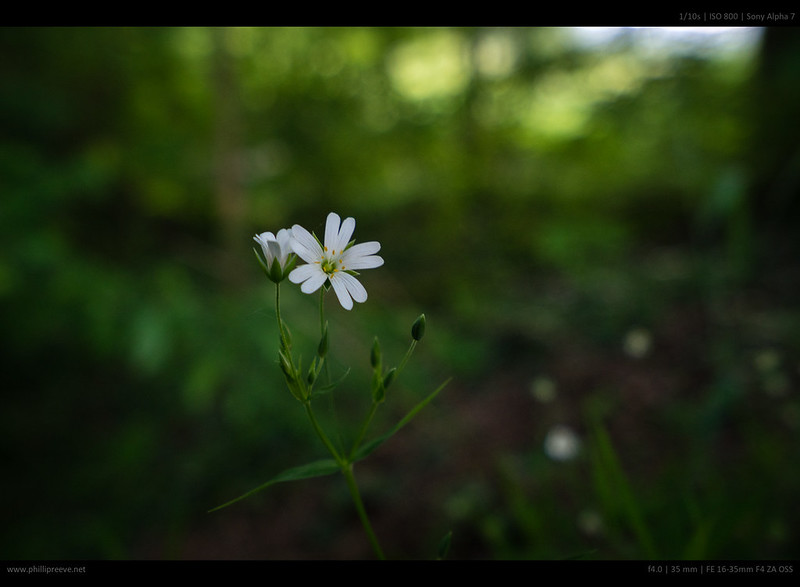
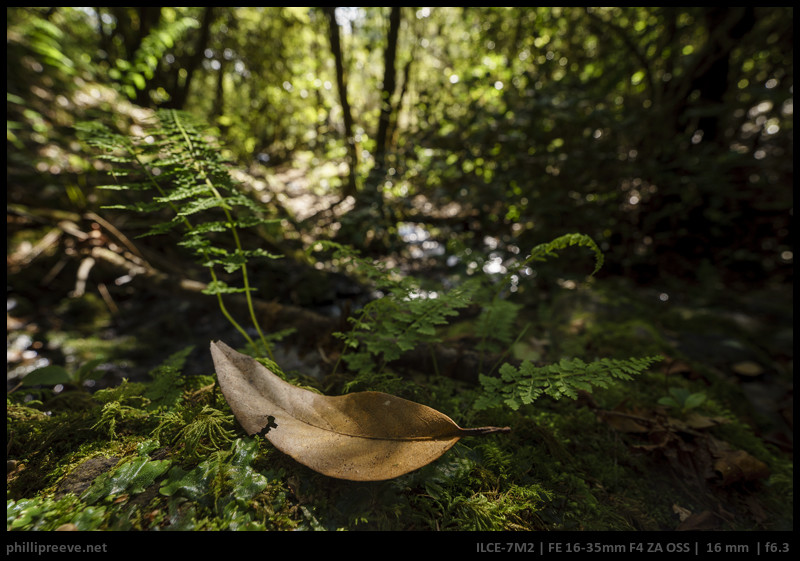

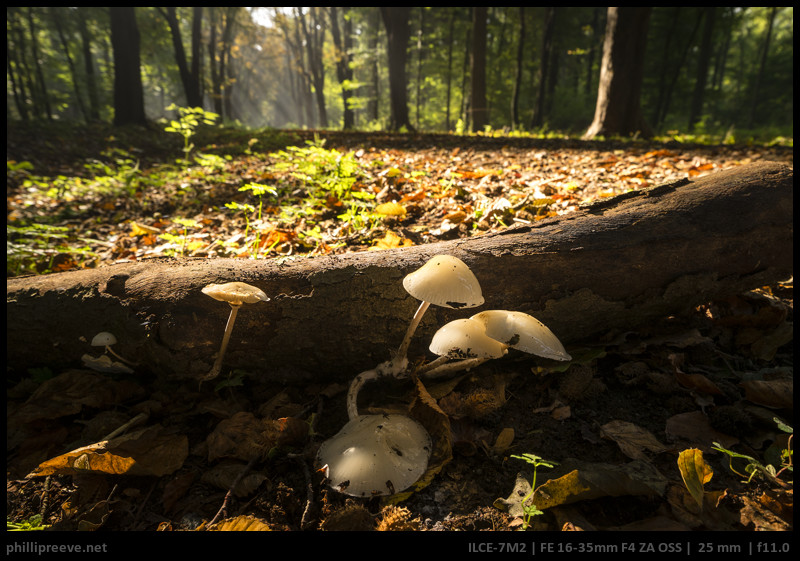
Compared to other lenses
The FE 3.5-5.6/28-70 and FE 4/24-70 ZA will perform similar in the center but the FE 4/16-35 has better corners, especially at 24mm.
The FE 2/28 has less field curvature so flat scenes will have sharper corners but more three dimensional scenes will have a little sharper corners with the SEL1635f4. It see a very small advantage for the 2/28 but both are very good at f/8 and I would base my decision more on size, price, versatility and the image stabilizer.
If money is less of and issue and your focus is on landscapes or architecture I would probably prefer the 16-35 because it is more versatile and the image stabilizer is quite handy.
I also compared it to my Canon FD 2.8/20: The SEL1635z has a higher contrast at wider apertures and still leads at f/8 and f/11. Stopped down to f/8 and especially f/11 sharpness is very similar, the FD even has a little advantage in the corners. Flare resistance is no contest: The Canon is pretty bad and the Sony quite good.
Zeiss Loxia 2.8/21: The Loxia is very sharp across the frame from f/2.8 and remains sharper off axis. It is also a stop faster than the Sony and has better flare resistance. I am still debating with myself whether I should replace my Sony with the Loxia because I would certainly prefer the handling and would welcome the sun-stars but so far the flexibility of the Sony wins.
Conclusion
pros
|
average
|
cons
|
Performance is very good and I find little fault with the lens: For the entire zoom range you get excellent central sharpness from f/4 and very good across the frame sharpness stopped down. The stabilizer works very well and it produces very nice sun stars. Optical problems like vignetting and distortion are well enough controlled that they are seldom a problem. Only the flare resistance has proven to be an issue at times.
I think it can be a very useful addition to many photo bags. Especially landscape photographers will enjoy the very good image quality and the wide zoom range. They probably won’t be too thrilled about the size and weight but that’s the price you have to pay for the versatility and compared to CaNikon’s 4/16-35 the Sony is quite small.
I think the price is a bit high but that’s hardly a surprise for any owner of a Alpha 7 series camera and compared with other lenses in the System the value is quite good actually.
All in all the Sony FE 4/16-35 ZA OSS is my lens of chice whenever I need to be flexible and I have taken many of my favorite pictures with it over the last two years. There flexibility and very good sharpness by far outweigh the smaller issues like the flare resistance and less than ideal manual focus. Highly recommended.
Price: $1348 at Amazon.com | B&H photo or cheaper at ebay.com, 1195€ at Amazon.de (affiliate links). If this review was helpful to you, please consider using one of my affiliate links. Thanks ?
Sample Images in Full Resolution
These images are processed from raw in LR
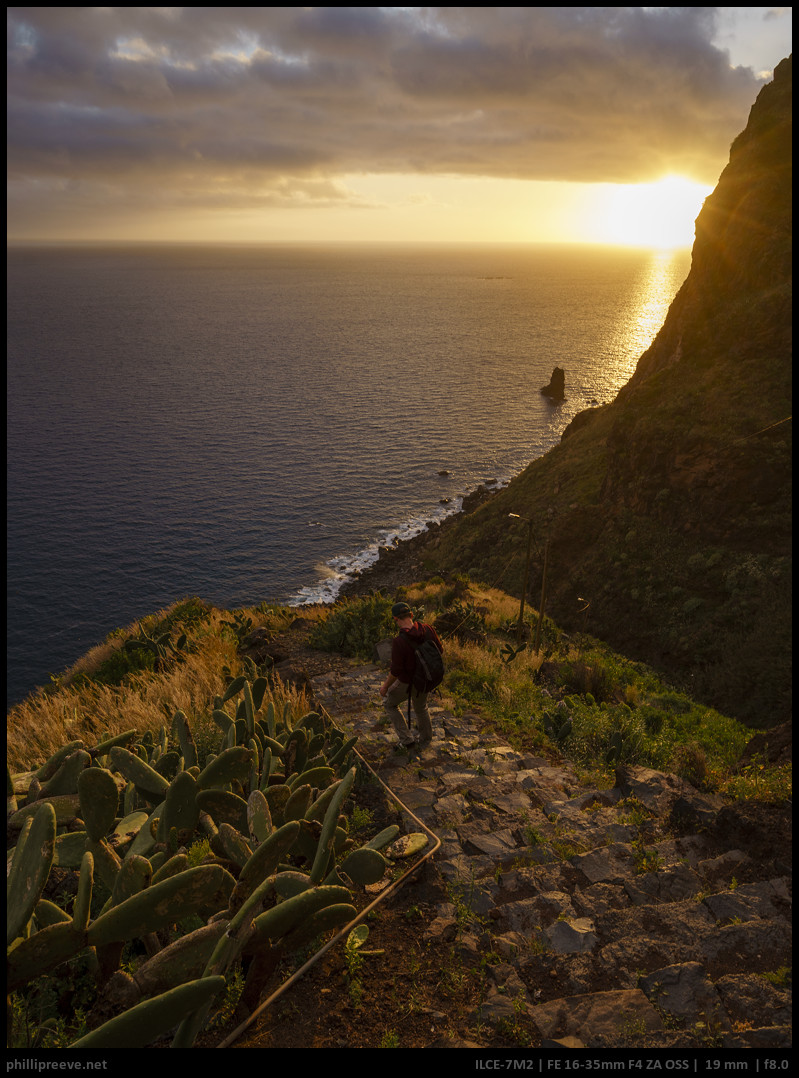

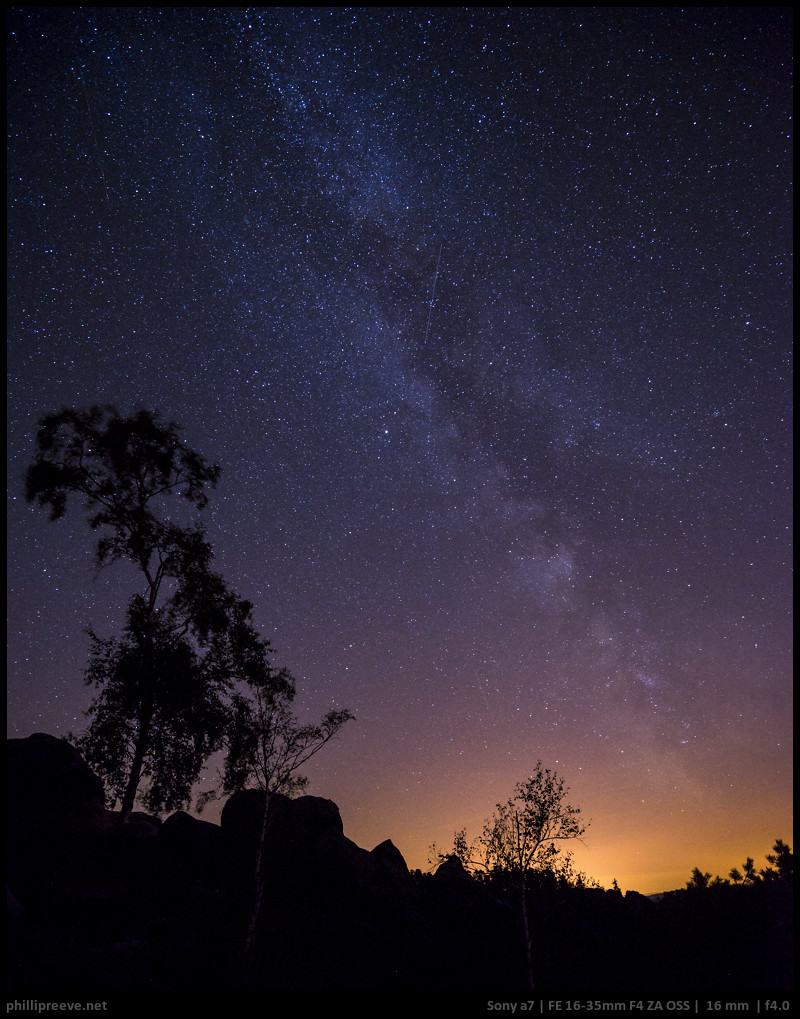
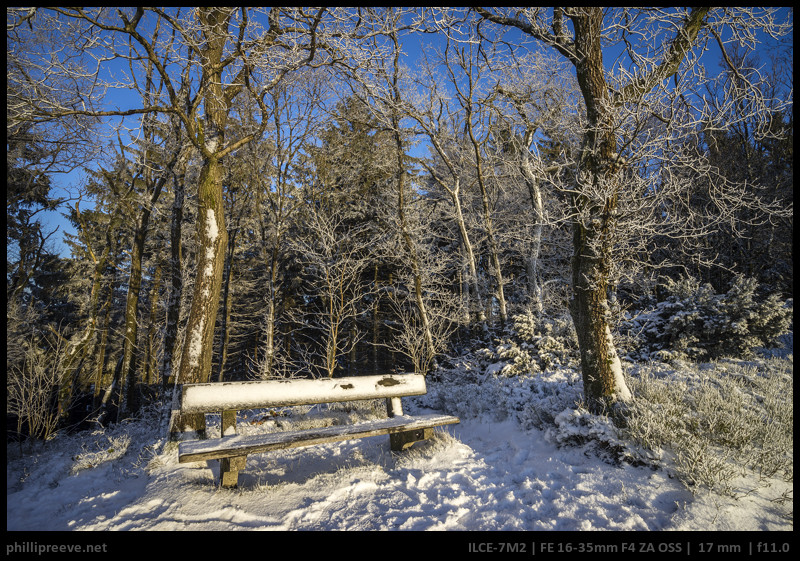

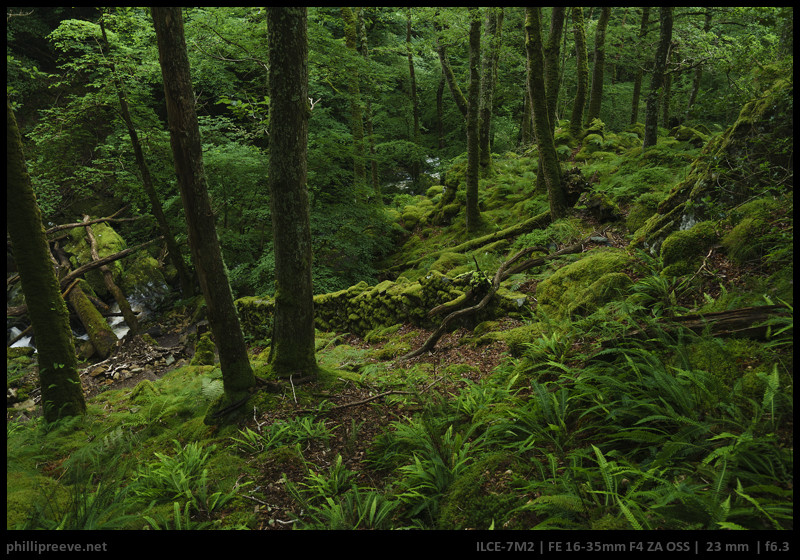
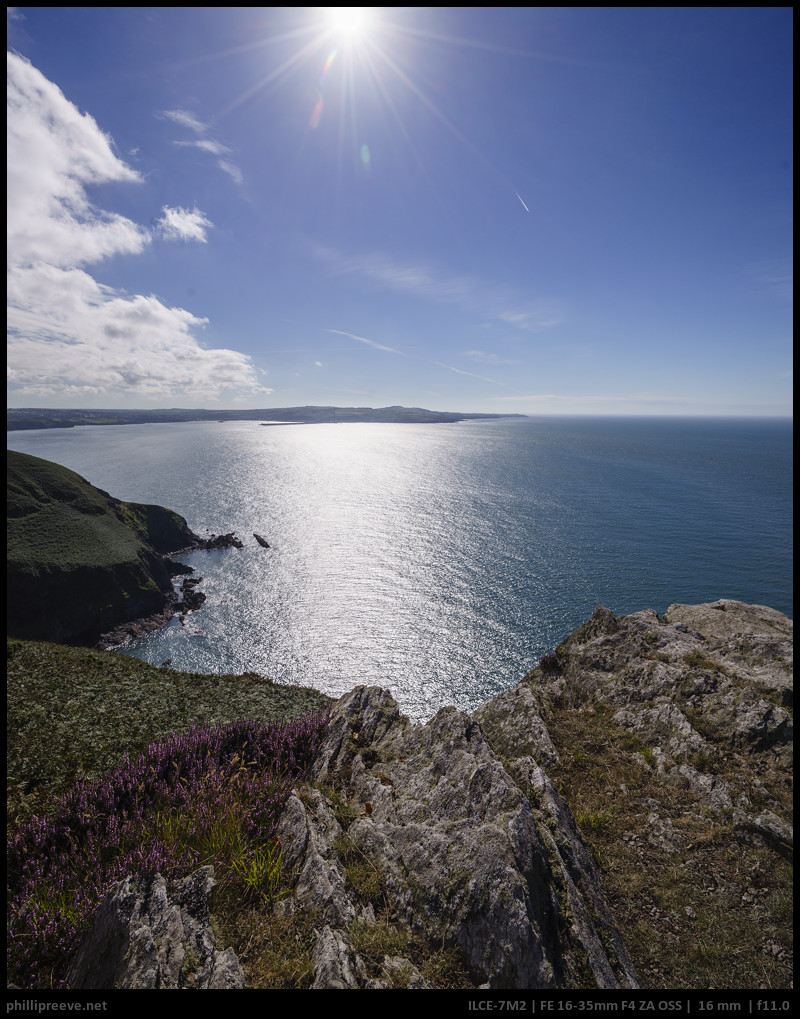
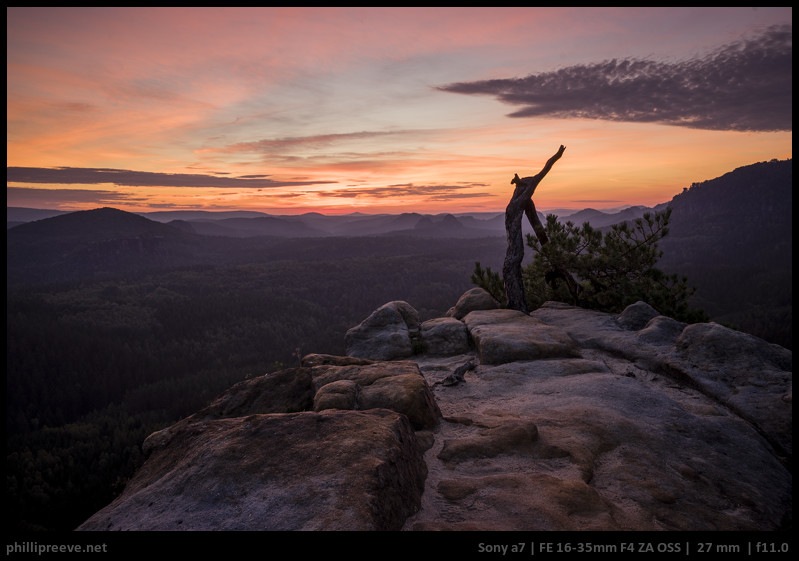
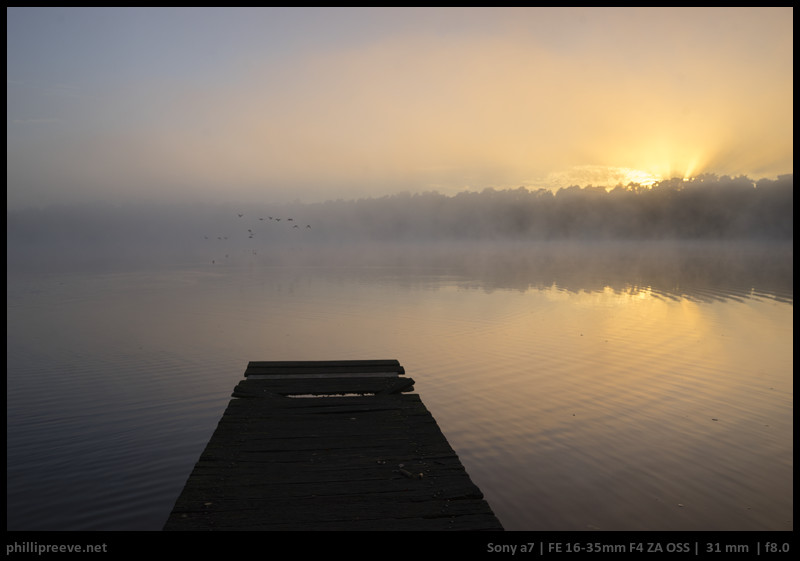

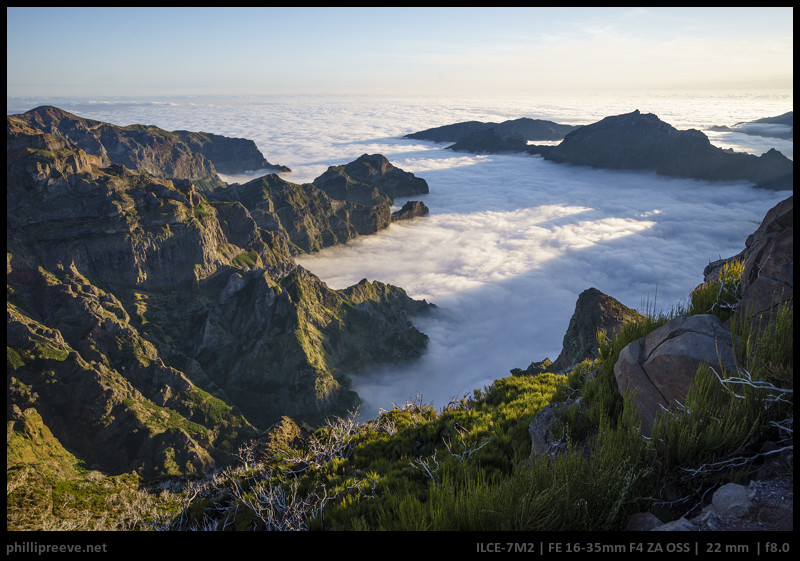


More samples in this flickr set: Sony FE 4/16-35 ZA T* full resolution samples
Other popular articles
- Sony FE 2/28 Review
- User guide to Ultra Wideangle lenses for the Sony Alpha 7 series
- User-Guide to wide-angle lenses for Sony a7 a7ii a7rii
This site contains affiliate links. If you make a purchase using any of the links marked as affiliate links, I may receive a small commission at no additional cost to you. This helps support the creation of future content.
Latest posts by Phillip Reeve (see all)
- Review: Samyang AF 75/1.8 FE - April 12, 2021
- The FE-List now has 113 lenses on it - March 25, 2021
- 2020 – Year’s end review - December 28, 2020
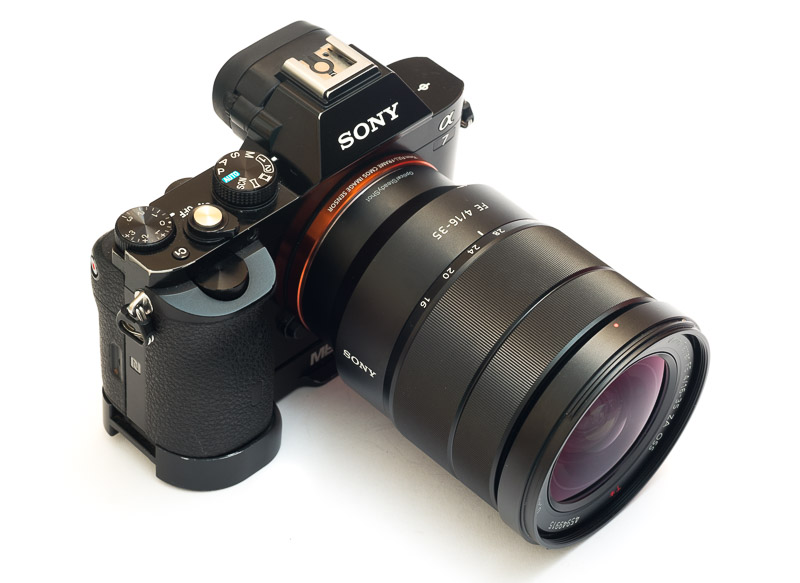
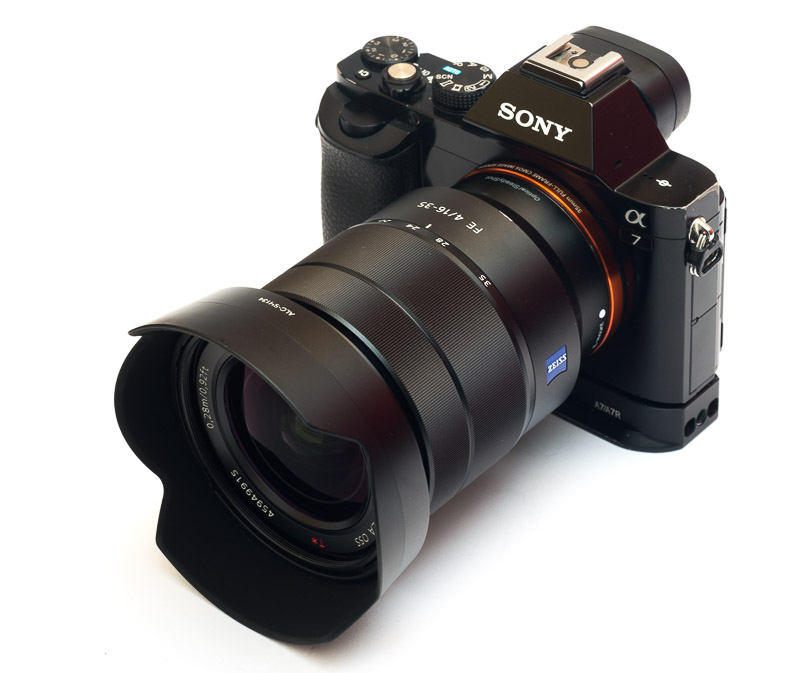
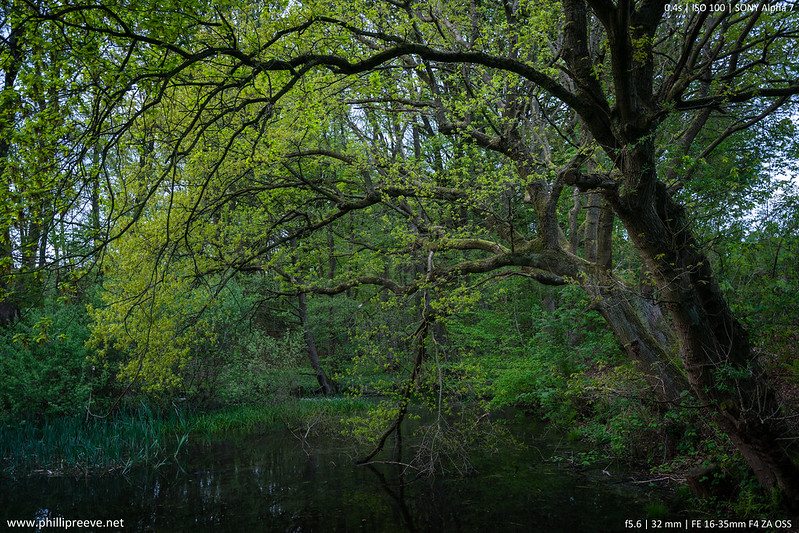
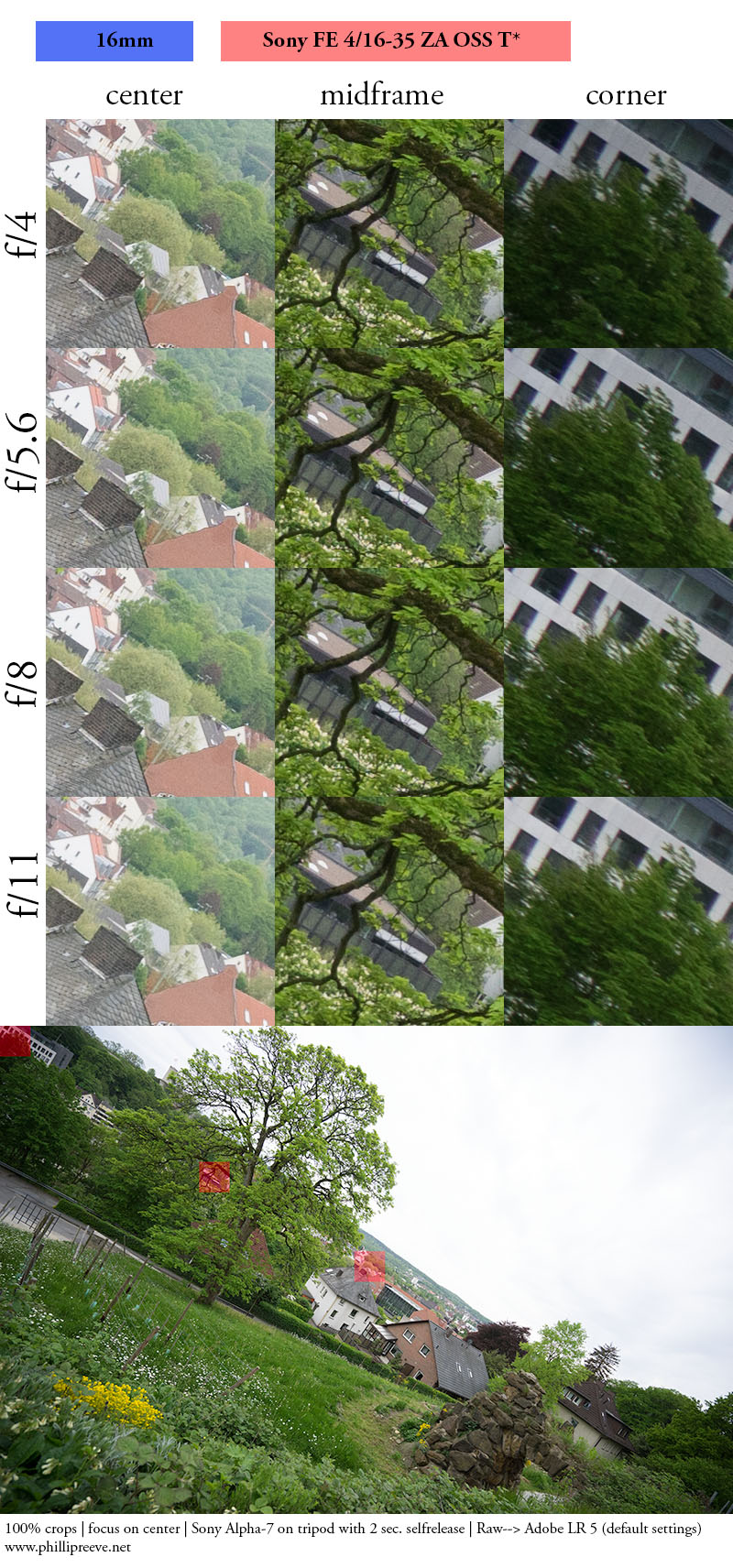
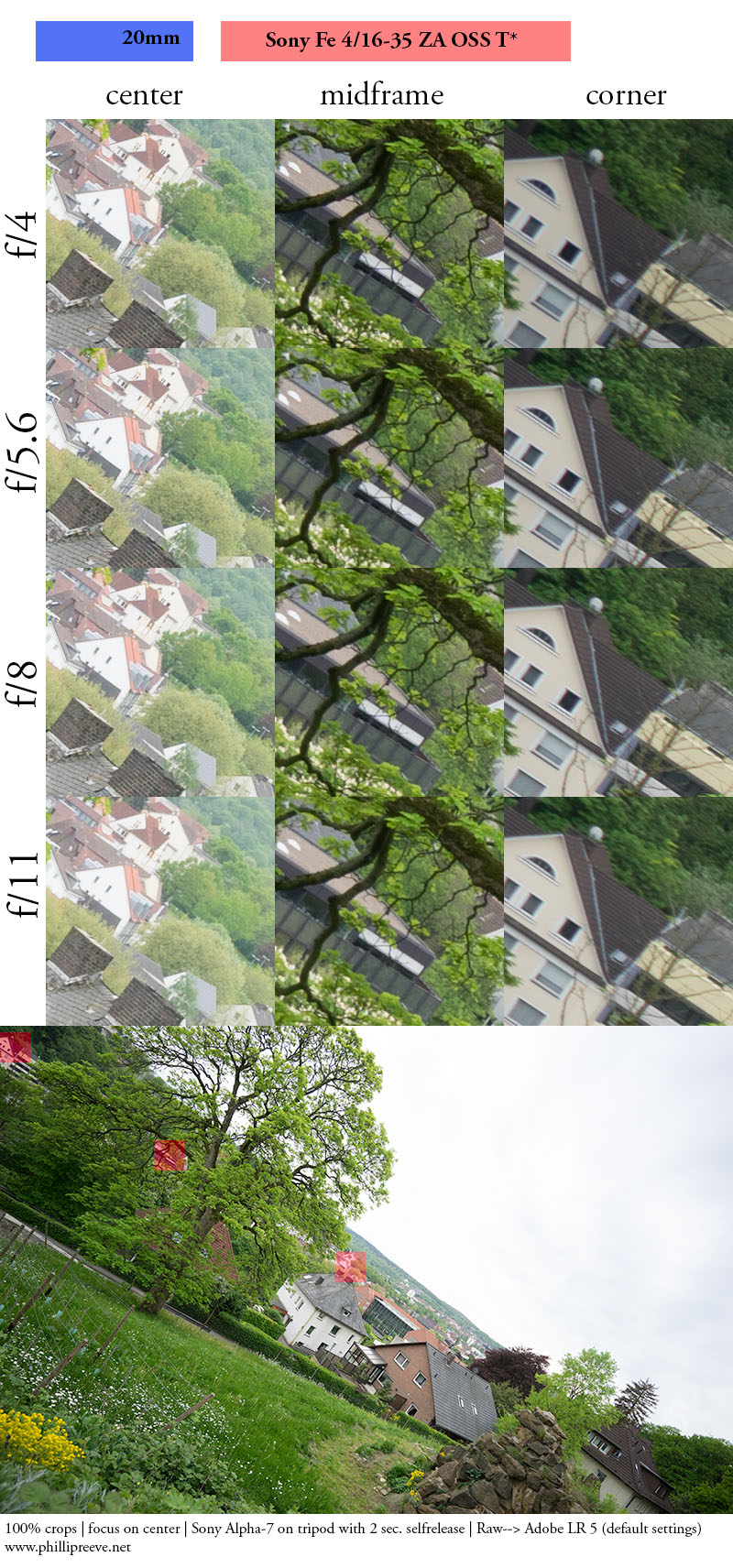
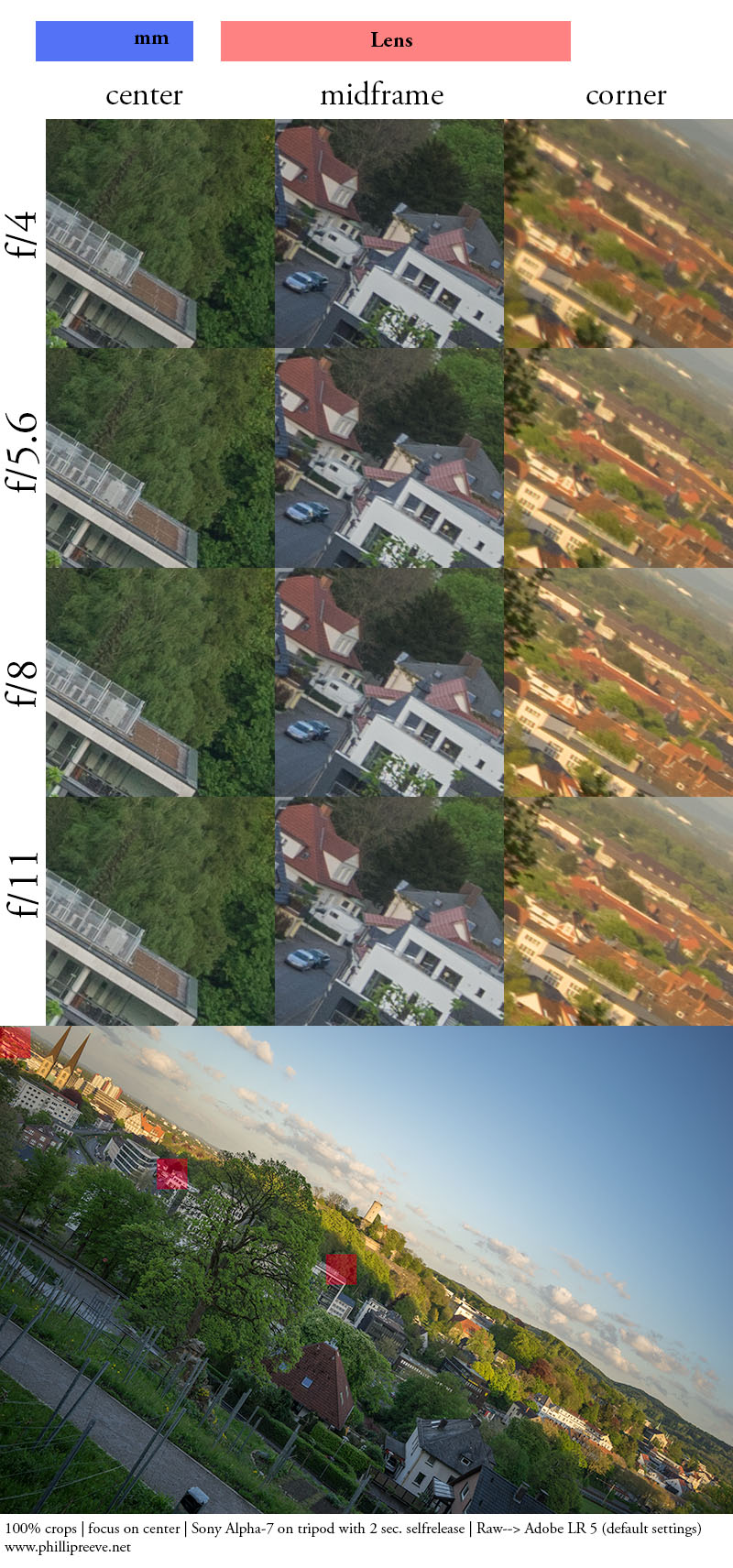
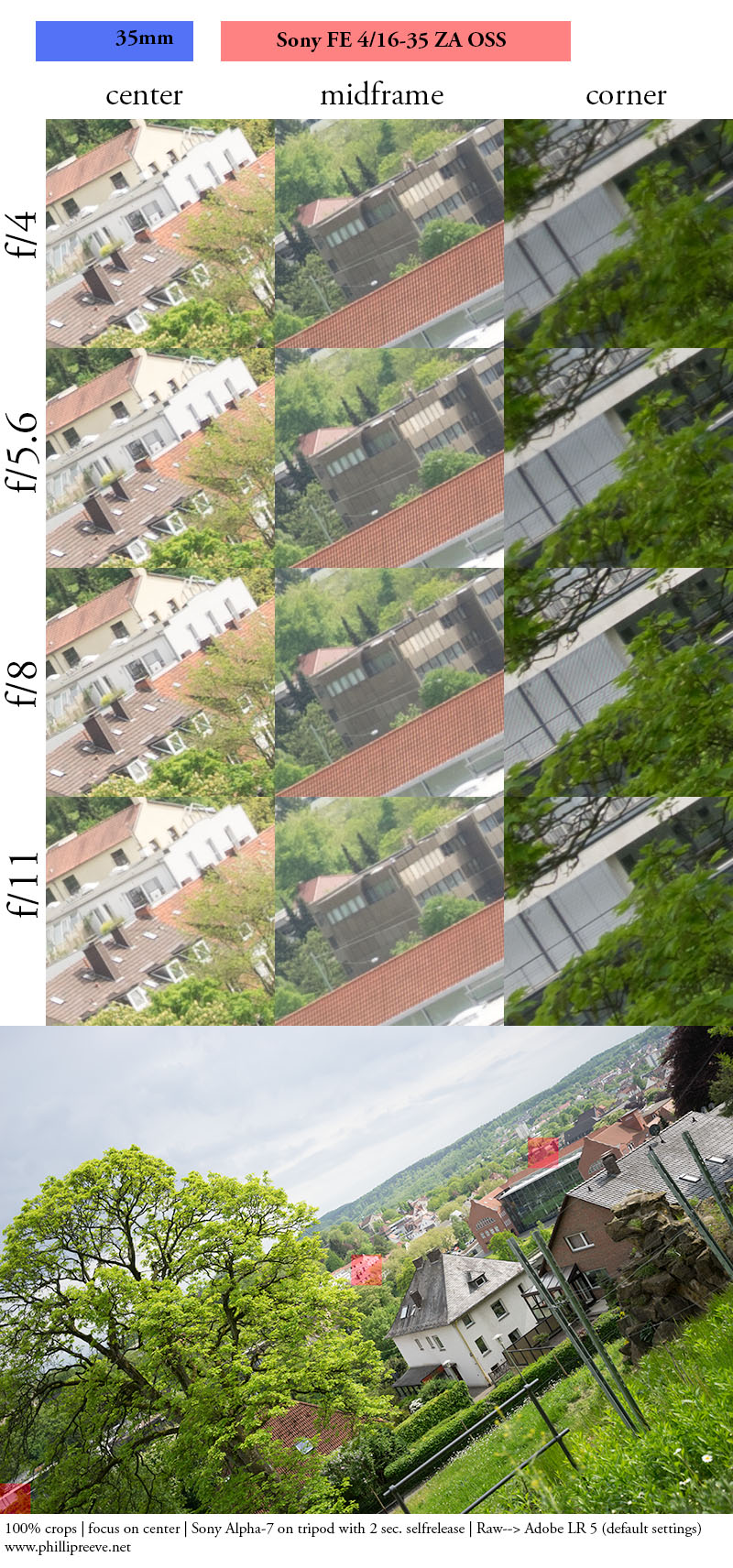
Philip,
Thanks for your good test, as always. It seems to be a great lens but I don’t think about buying it right now because of the price.
Whot would interest me also is a comparison to the 16-35 A-mount lens + the LA-EA4 for Sony, which has a better aperture that could help in low light situation or for star / Milky Way pictures.
I think the extraction of objects is not that interesting for such a wide angle lense.
From what I have read the 4/16-35 has better corner sharpness. For Night Sky Photography I would probably go for a Samyang prime if I was really serious about it.
I have the Rokinon 14mm for star photography, and I’m not super impressed with it. Hard to correct mustache-distortion and soft, usually too distorted corners have made it difficult to use on the A7S.
Ein Vergleich zum Canon 16-35/4L IS am Metabones Adapter wäre interessant. Das Canon ist ja doch einiges günstiger, aber vielleicht nicht schlechter?
Ich habe mal einen kurzen Vergleich gesehen, dabei kam das Canon etwas besser weg, wie ich ja auch zum Ende des Artikels schreibe. Leider kann ich ihn nicht wieder finden.
Grüße,
Phillip
Tony Northrup hat die beiden verglichen und meint, dass das Canon mit Adapter an Sony A7RII schwache Ränder habe, eindeutig schwächer als das Zeiss/Sony – obwohl das Canon an Canon besser sei als das Zeiss/Sony an Sony. Strange, aber seine Bilder belegen es.
Ich habe es auch (das Z/S) und finde es wie Phillip für ein WW Zoom ziemlich gut, mit viel Mikrokontrast. Da ich von Nikon her komme, kann ich auch bestätigen, dass es wesentlich kontrastreicher und randschärfer als das 16-35 Nikkor ist. Festbrennweiten müssen sich ganz schön anstrengen, um besser zu sein. Wie Phillip kann ich auch keine “unscharfen Ränder bei Bl. 8” beklagen, wie ein weiterer Kommentar meint – und ich bin da kritisch. Unschärfer ja, unscharf nein.
Gruß und vielen Dank an Phillip,
Uwe
Der Northrob hatte zienlich sicher einen zu kurzen Adapter
Danke für deinen Bericht! Da bringst du mich ja nochmal ins Grübeln.
Ich hatte schon einige Zeit rum überlegt mir das Objektiv zu holen, hatte dann jedoch davon abgesehen, nachdem ich das Objektiv bei einem Bekannten kurz testen konnte und weite Randbereiche bei Blende 8 wirklich unscharf waren. Vielleicht lag es ja an seinem Objektiv und ich sollte es mir nochmal genauer anschauen.
Lg
Peter
Also von wirklich unscharf kann wirklich keine Rede sein. Ein gewisser Randabfall: Ja: aber unscharf würde cihd as nicht nennen
Hello Phillip,
I own the 16-35mm lens and I enjoy it very much as it is a fantastic lens! I’m a wide-angle shooter and I’m interested by the new Batis 25mm f2 for the speed. Do you think it will bring me that much compare to the 16-35 at 25? Thanks for your thoughts and congrats for your site and reviews!
Regards,
Fabien.
I guess it could be a bit better in the corners but I wouldn’t expect much of a difference.
For whomever was asking this question… The Batis 25mm will blow the 16-35 out of the water in every possible way… Except for versatility of course. Sony-Zeiss is not exactly the same as pure Zeiss. The Batis has been compared to $4000 lenses and it still holds its own. What it depends on is your needs… If versatility is more important than pure utter sharpness.
And it would be nice if somebody would proof-read Phillips articles before hand.
That’s a very vague description, were exactly do you see an advantage for the Batis besides the already mentioned moderate advantage in the outer 10% of the image?
Is that an application as proof reader 😀 ?
btw, beforehand is one word, not two.
Allen wrote: “And it would be nice if somebody would proof-read Phillips articles before hand.”
I think he meant to write: “And it would be nice if somebody would proof-read Phillip’s articles beforehand”; an apostrophe added by me to correctly form the possessive, and “before hand” changed to the correct “beforehand.”
Two proofreading errors in his short sentence about proofreading are not a great performance by Allen! But it is true that while Phillip’s English and writing are excellent, there are a few errors that a native English-speaker would be likely to catch and the correction of which would better do justice to the excellence of Phillip’s reviews (e.g., “there” vs. “their”). It might be useful to run the articles through Microsoft Word’s grammar checker–it would flag most of the mistakes.
Let’s begin with the fact that wide-open its edge to edge sharpness. And it’s even sharper dead in the middle. No way I can prove that to you. But it is.
For some people that’s not a big deal. I’ve not gotten to spend a lot of time with the lens… but from what I’ve seen, I would call it magic.
And in my opinion… What good is a fast lens if it’s not sharp edge to edge. What good is painstaking composition if it’s not sharp on the edges?. The lens is like magic. I’ve seen the end results and I’ve never seen a lens any sharper than this.
Zeiss told me that if 2000 copies of the lens came in today, not one copy would sit on the shelf. There must be something going on… Unless it’s simply mass insanity.
Sure the Batis 25 has exceptionally sharp corners from f/2. But I know very few applications where I need sharp corners at f/2, night sky photography is probably the only one which comes to my mind.
Corners sharpness matters to me at f/8 or f/11 and here I see some advantage for the Batis but they aren’t far apart and I only see a difference in the outer 10% of the image. Here are two full resolution images at f/8:
https://www.flickr.com/photos/dierktopp/20055709135/in/album-72157654089703684/
https://www.flickr.com/photos/dierktopp/20048046492/in/album-72157654089703684/
Hi Phillip,
thanks a lot for the very informative review!
By a chance, do you know if those images were taken from the same distance?
I’m asking because it looks like Batis is wider that 25 mm (judging from the aforementioned images it’s wider than the zoom at 24mm)
Regarding the Batis f/2 25mm: many reviews state that this lens was really a 23mm lens, being wider than normal 24mm lenses. So probably those images were taken from the same distance.
You’re shooting a movie… A thriller… The closet is on the edge of the frame… the killer sticks his gun out from the closet door on the edge of the frame. You’re shooting at low light levels so you want to be wide open. So the gun comes into the corner of the frame out of focus? ? Hmm. Just another of the many examples why edge sharpness is important.
On the 16-35… Didn’t get to test this… But when you’re at 35mm I was told the lens goes soft?? Is that true?
I think thats not a very good example because at those resolutions the 16-35 will be excellent across the frame at any setting.
About 35mm: Photozone reported excellent performance in the center but a very noticeable loss of corner resolution. I think at longer distances this is less pronounced and gone by f/8. Even at f/4 it will be noticeable only when the image is enlarged a lot.
Have tested the 16-35 at 35 against my FD 35/2 which was for me sharp enough.
At all comparable apertures and 100% crop the 16-35 looks sharper all across the frame. A tiny bit but still, it is noticeable.
Don’t know how it compares to the FE 35.
A lot of people complain about the 16-35 at 35mm.
I agree it’s not sharp outside the centre wide open at 35, but by f8 it’s a perfectly fine landscape lens: it seems to be as good as my c/y 35-70 at 35mm and f8, which is impressive!
All the other focal lengths are good to excellent over most of field from wide open. All in all this makes it an extraordinarily good UW zoom.
Thanks very much.
Thank you for a great review.
I recently bought a “like new” Sony A7 and I am happy about it! (There is no flash PC socket).
I was readiong about Leica WATE with a view to purchase but this review has put a stop to my intention to go for a Leica WATE.
I would like to know if anybody can advise me wether to go for one or the other. Apart from a big price difference there is also a performance difference between Leica 16-18-21 and Zeiss 16-34 F4. How can Leica justify the price of WATE and Mate.
I know some Zeiss lenses are also very expensive but they reflect their price in build and performance.
For a comparison with the WATE check out this very informative comparison: http://3d-kraft.com/index.php?option=com_content&view=article&id=171:adorable-uwas-zeiss-leica-voigtlander-olympus&catid=40:camerasandlenses&Itemid=2
Thank you Phillip, I read the link you provided. The WATE is excellent when stopped down to F8 as stated in the review update towards bottom of the page.
Whereas Zeiss is excellent to begin with. I know that the advantage with Leica lens is that it can be made to work with most (modern) camera bodies. This Zeiss lens may be limited to Sony only.
Thanks, Phillip, for all your excellent work on this site!
I recently purchased a Sony Alpha 7R II, and a Sony Zeiss Sonnar T FE 55 mm F/1.8 lens.
After extensive research, with a plan to acquire 2-3 lenses between focal length of 14 and 35 mm, and after reading your superb review of Sony Zeiss FE 16-35 mm F/4 lens, I have finally concluded, that I will go for this FE 16-35 mm lens from Sony Zeiss.
Further, after waiting for the Zeiss Batis25 mm F/2, for many many months, here in the U.S.A., B&H Photo, I was getting a bit tired of ever-changing availability date!
Moreover, I thought that if the prince of manual lenses – Phillip Reeve – has enough conviction to carry this lens in his camera bag, this lens can’t be too bad!
Ich danke Ihnen für Ihre ausgezeichnete Artikel zu den Themen der Fotografie.
Herzliche Grüße aus Texas!!
Danke Arun 🙂 and good luck with your a7rii!
Howdy Arun,
I live in the Dallas area and have been a huge follower of Phillip’s posts. I shoot with a A7RII as well and have a fairly large collection of Minolta and Tokina manual lenses along with the Sony 16-35/f4 and FE 28mm/f2.
Cheers,
Rajesh
I own the Vario-Tessar 4/16-35 OSS and I must say that I disagree with your conclusion. The lens has been a disappointment in most respects. At it’s price point, it manages to be out performed by the (cheaper) Canon 4/16-35L. It even manages to be out performed by 35 year old primes — I did comparison shot of the same scenery with the 16-35 @ ~21mm and @ ~ 28 mm with my adapted early 90s vintage Carl Zeiss 2.8/28 Distagon and 2.8/21 Distagon (Contax MM mount). Vs the 28 Center is about the same, the 28 is sharper all the way through 60~70% of the frame edges are again about the same. The 21 was better in every respect from center to edge. The 4/16-35 also distorts as much or worse, so no saving grace there.
I feel that the two Vario-Tessars were disappointments after the superlative 1.8/55 set the standard for the FE mount — the 1.8/55 is basically a baby Otus, LOL! The 4/16-35 is simply a lesser disappointment than the appallingly bad 4/24-70. With zooms I can excuse a small max. aperture, I can excuse slow focusing, I can excuse weight, I can excuse bulk and I can even excuse price. But a 2x or 3x zoom should — in the Zeiss tradition — be the equal of primes in image quality. These two Vario-Tessars clearly are not. It’s a pity because they looked good on the outside and the handling is excellent.
I really hope that Zeiss will do a small 2x zoom on the Batis line. I’ll clamor for a Vario-Sonnar T* 4/25-50 that is about the size of the 1.8/55. It’s a wide zoom, so it’s primary mission to be as sharp as the 1.8/55 when stopped down to F8. Keep it simple, no need for OSS, no need for a big aperture, need for a wide zoom range, no need for a fat aperture.
The Canon is a bit better in the corners, I agree about that. But it is also quite a bit bigger and the difference isn’t huge. Does it have the better price/performance ratio? Sure. Does that make the FE 4/16-35 a bad lens? No. It is one of the best UWW zooms in the market.
You don’t mention at which aperture you compared them but the 2.8/28 needs f/8 for good across the frame results and even then the extreme corners remain soft. I a bit surprised that you see a significant difference in the center and midframe region, I compared them and the difference is quite small. I have never used the C/Y 2.8/21 but it is really big and really expensive.
Zeiss’ only UWW zoom I know of is the Contax N 2.8/17-35 and that is certainly not as good as their own primes, so yes there are a few excellent zooms like the 3.4/35-70 but there is no Zeiss tradition where all their zooms are as good as their primes.
After the review I bought a 4/16-35 and I am still quite happy with it. Usually I prefer to use small manual primes but whenever I need the flexibility or wide angle I am still quite happy with the images. I can understand your wish for a small zoom, I would have liked a small 4/18-28 even more but I am much happier with the 16-35 than I was with the 24-70.
The
should i worry about the apparent build quality (picture quality) variations from one example to another
with Sony lenses (and most others) you should always check it
Hi,
Love your reviews.
Did you get a chance to tray out the Sony 10-18mm on the a7 .
If possible tray to review it of an FE mount
It’s a small and light lens that compliments the a7 series
Not yet and it is unlikely to happen 😉
Hi Phillip,
Thanks for your profound review of FE 16-35 lens. I have to admit that it finally convinced me to buy this lens for my A7 II.
I have been using it for the past few weeks. While stopped down it is very sharp. No contrast problems when shooting with sun in the frame.
However there is one thing with this lens which is strange – whiz/hiss sound when rotating zoom ring. Increasing pitch when zooming towards 16 mm end and decreasing pitch when zooming in opposite direction. Is it normal for this lens? I have not noticed such behavior with my FE 70-200 f/4 zoom.
Hi Phillip,
I will be greatfull for any comment here.
Regards.
Sorry for the late reply, didn’t have access to my copy. Mine makes a small noise, more like felt grinding against a ring, I wouldn’t call it a hissing sound.
Thanks Phillip,
It allows me to sleep well tonight 😉
Regards
Phillip,
As so many have already stated, this was such a helpful review. I do own this lens, but have only had if for one actual shoot session. I really enjoy it, and I am looking forward to many photos coming from this and my a7.
I’m wondering if the Voigtlander 15mm f4.5 III has any advantages over the 15-35mm? I like the build quality, size, and manual focusing, but specifically I’m looking at a lens for astrophotography, and after briefly owning the Rokinon 14mm I wasn’t convinced it would be a good long term lens because of the build quality, and I struggle with focusing as the focus peaking seemed inconsistent. I also like that the new version of the Voitglander has EXIF data.
Thanks for the insightful writing.
Matt
I think the Voigtländer is a great choice if you value manual focus and small size but it doesn’t offer much over the FE 4/16-35 optically. Despite it’s shortcomings I would go for the faster Samyang 2.8/14 for astro
Phillip,
Thank you for the feedback! I keep reading/seeing/hearing and now better understand the issue with faster and slower lenses. The new Tokina looks interesting, but I can seem to find if it provide data like the Loxia and Voigtlander do. Again, I’m not against manual adjustments, it feels pretty natural, it would just be helpful for me to see the data in the viewfinder.
The new Samyang/Rokinon 14mm auto-focus model looks like an interest option, too.
Thank you again,
Matt
Hi Philip,
it is not clear to me if the sony 16-35mm is usable on the sony alpha 7 without an adapter. It’s all about the Sony 16-35mm Vario-Tessar T FE F4 ZA OSS. it is not clear to me if the sony 16-35mm is usable on the sony alpha 7 without an adapter.
There is also a 16-35mm A-mount.
Thanks
Mathew
no adapter needed, this is a native E-mount lens
The review talks to the native however there is an A mount lens.
Hello, can anyone suggest Batis 18/2.8 over this?
Sure if the speed and a bit better corner performance matter more to you than the flexibility of the 16-35
Hi Phillip. Thanks for the excellent review as always.
The sunstar of this lens is also a mixed bag for me. I’d say if it is more defined I would’ve bough this lens long before.
Is it possible to add an aperture series showing the shape of sunstars?
I will see what I can do 🙂
Thanks in advance!
Hi Philip, nice review. I have also owned the lens for about 1 year and will be holding on to it for sure. I seem to have a very nice copy with sharp corners at 16-28 range but then softens on the 35mm side. Another thing I have noticed is a lack of reliability on the AF at 35mm where it can sometimes miss focus. Regarding weather sealing, it seems OK as mine took a little tumble on a shoreline….
http://petapixel.com/2016/12/01/sony-uk-said-camera-beyond-repair-sony-thailand-fixed-120/
I would still be much more confident with the Canon 16-35 in tough weather conditions though.
Thanks for the review and overall great content!
My FE 16-35/4 produces a ring type flare (a rather big one) at 16 to about 23 mm. I mostly shot at f16. You didn’t mention this in the review, doesn’t your copy do this?
Well I show a sample image of this flare, so yes it does.
Phillip,
Thanks for the update of the review.
I’ve had the same inner (voices in my head) debate weather to go with the zoom or the Loxia 21. I bought the zoom a year ago and I’ve been very happy with its performance. Then in February I did some research trying to find out what focal lengths I actually was using on the zoom. I came to the conclusion I was shooting mostly either at 16 mm or 21-24 mm. With that as input I decided to get the Loxia 21. (It could have been the other way around too, that I wanted the Loxia and went searching for justification to buy it 🙂
Perhaps with the thought, that did I like the Loxia, I could get a 15 mm prime and sell the zoom.
So how do they compare?
Well, Loxia is the optically better lens in almost every aspect, but then that was expected. Perhaps the zoom is a little bit sharper in the center, but then it’s down to hair-splitting and serious pixel-peeping.
But optically is not everything. The zoom is convenient, has auto focus and stabilization. Does the optical prowess of the Loxia outweigh this?
For me the answer is yes, and it comes down to the following points:
– Micro-contrast. The amount of detail the Loxia can resolve in particular shadows are amazing. With the zoom the same shadows are significantly less detailed and uniform in color. It’s hard to say no to this when you’ve seen the difference.
– Flare resistance. As I mainly shoot landscapes, often with a low standing sun, the difference in flare resistance is a big issue.
– Color rendering. This is of course a matter of personal taste but I like the Loxia’s more red rendering to the zoom’s more warm yellowish colors. This can be seen clearly in skies where the Loxia renders more towards blue and the zoom towards cyan.
Conclusion is that I’m now out looking for a prime around 15 mm so I can sell the zoom.
Thanks for sharing your experience 🙂
@Lasse: Could you provide some further longterm experience with me? Because I’m in the same situation as you were (want a WA lense and can’t decied between the 16-35 and the Loxia 21).
@Phillip Reeve: It there any change ot get a direct comparison? As far as I know your colleagues are shooting wide angle with the Loxia 21…
PS: Found a typo:
All in all the Sony FE 4/16-35 ZA OSS is my lens of CHICE whenever I need to be flexible and I have taken many of my favorite pictures with it over the last two years. (see it as application as proofreader 😉 )
Nice write-up, as usual on this website, THX for that!
The Sony 4/16-35mm seems a fine lens, surely better IQ as the Minolta 17-35 with adapter I use from time to time……..
If you still question yourself if you would like a Loxia better, I think YES! In your hands this is such a powerfull tool for most photo situations. The handeling is great, and the one focal lenght keeps shooting more simple and so (much more) enjoyable.
Keep up the good work.
Greeings from Holland
Hi! I have this lens for three months now. I corroborate the refereed performance and also had to add that it resisted a 4 mts fall directly to salty water wet rocks and survived with minor scratches in the metal!
Interesting read. I am wondering what to do next. I currently only use primes on my A7R2 . I have batis 25mm, FE35mm f2.8, FE55mm, GM 85mm. I do a lot of landscape and have been considering selling my batis and 35mm and buying the new 16-35mm GM. I would like the have a wider option so batis 18mm is another option i am considering. I really like the batis 25mm lens and I know the 18mm is also very good but the flexibility of the 16-35mm is very appealing.
I have used this lens daily on an a7rii for the past two years and was very satisfied until recently. While in Iceland I found that it wouldn’t focus when shooting in cold weather. Below 0° C, the lens would fail to focus. I could hear the internal focus motor running and it would drain the, already limited capacity, battery quickly. Putting the camera and lens under my coat to warm it up would solve this problem temporarily. After warming up, the lens would function again for about 15-20 minutes before failing. On my return home I stopped in Seattle for a couple days and the lens performed flawlessly in 40° F temperatures. Now that I’m back home in Hawaii, I have no problems. My experience is not scientifically proven but, in my experience, this lens is not for those who will be shooting in a below freezing environment.
thanks for sharing. I have used it in -5 °C weather without issues but only a few times
Hi, at first great review and website, congrats and thanks for sharing your experience! I’m thinking to buy this lens, have you any example (or just opinion) for using it to do some portrait (30-35mm range), i know the lens is not designed for that use but i’m sure i would use it for that also (even if my priority is a ultrawide lens).
Hi. Love your blog. I have the FD 17/20/24/28/35mm and payed around 550eur total. Now i started wondering if the 16-35/4 is worth selling all of them to buy the sony at a pricepoint of approx. 300eur more (used). Im pretty sure performance will be similar, probably a bit better for the sony at 17mm. What do you think? I will definetly love the flexibility but certainly miss good manual controls..
I sold my FD 2.8/20 to partially pay for my 4/16-35 and didn’t regret it. The better flare resistance, stabilizer and contrast are nice to have and it isn’t much larger than the FD 2.8/20 with adapter.
If you do the swap I would probably keep the 2.8/35 which is optically the strongest of your set while being the cheapest and smallest. Also the 16-35 is a bit weaker at 35mm.
Hey Phillip, thanks for the detailed article!
I got a question, do you think paying almost 2x and going after Sony 16-35mm 2.8 GM version of this lens is justified or in 2018 you would still stick with f4 version that is a few years old?
Thanks
I couldn’t justify paying for it, no. But it is without question the nicer lens.
Hi Phillip,
do you know how the Canon EF 17-40 f4L compares to the Sony. After all its a lot cheaper
Not in the same league.
On top of that for ultra wide angle lenses you should be using the Sigma MC-11 adapter and not one of the cheapo ones.
That will somewhat negate the price difference.
I used that Canon in my canon days. It was OK in its era, but not competitive with current lenses.
Hi Phillip,
Mostly I take landscape and with my family togather (6people) while traveling.
I am buying A7iii, and struggle to choose the lenses . planning to get 24105, however I like the effect and the wide angle like gopro does .
However the gopro hero 5 do not have good quality for photography especially in low light condition. So after read through ur review I am thinking to get a 1635 F4 instead of 24105.
I am concern about the performance in night time /low light .
Maybe I should get another lens for low light and any suggestion from you ?
Ps : normally I didn’t change the lens frequently, but is ok to change for day and night .
What are your concerns for nighttime shooting then?
without flash , I need to push a lot of iso , and normally the image is full of noice .
Thinking to get Sony 1653 + 55 1.8 Z or Samyang 35 F1.4 . ?
I’ve got a bunch of legacy lenses that cover the same focal length, canon 17mm, pentax 20mm, olympus 21mm, Minolta 24mm, etc that seem to work OK but it is not too much fun carrying a bunch with me so the zoom idea is appealing and I’ve been considering purchasing this lens.
don’t want to beat a dead horse with a question already asked but I’ve got the MC-11 along with a sigma 150-600 so that cost of the adapter has already been accounted for.
Locally there are some Canon L 16-35mm f2.8 lenses used for $6-700 along with the f4 versions being cheaper. It sounds like the canon F4 version doesn’t compete, but would the f2.8 version?
The Canon 4/16-35 L is about as good as the Sony. So if you are fine with handling and bulk then go for it.
I have seen some positive reviews of Tamron’s new 17-35mm.
It is f / 2.8~4.0 and lower cost, although no image stabilization.
Have you or any of your colleagues tried it with the Sigma MC-11 adapter ?
We haven’t and most likely won’t since we are all already well covered in that region. To me the hassle to deal with an adapter and the bigger size and increased weight would not warrant the money savings even if the Tamron performed as well as the Sony (and I have no idea if it does).
Hello Phillip,
I just bought the 16-35 F4 based on your recommendation. I find your reviews to be amongst the most comprehensive. Keep up the excellent work!
Hi Phillip, very nice read,
I’ve read in multiple websites that image performance is appalling at 35mm f/4, could you comment on this? Basically I’m wondering if – beyond landscape and interior photography – I could also use it as a second lens for event coverage, occasionally zooming at 35mm at full aperture for portrait with slight background separation.
All the best
Hello Phillip,
What filtrs do you use on this lens?
A normal, not that thin polarizer.
hi Phillip and crew,
I do love the 16-35 ZA – bought one when it first got out and it gave me many beautiful shots through the years. I use it for landscape/backpacking.
If you were so inclined, I would love to see your take on the GM 2.8 version and a comparison. My temptation for landscape/backpacking is that the GM while bigger/heavier/pricier could nix the need for a separate astro lens… which in the end might be lighter and cheaper. That said I only have good things to say about the ZA – while flares are an issue to look for, and the dumb hood covers the image at 16, the sharpness/microcontrast/color/oss/size and weight are lovely.
By any account the GM is the better lens but at the price it costs I am not too inclined to review it.
Well, I answered my own question 🙂 Rented a 16-35 GM to go shoot the wildflower bloom in the Anza Borrego desert last week-end.
Here is what I found out:
Lens is a joy to use, manual focusing is pleasing and effective, focus switch on barrel, good zoom ring. Small minimum focus distance allows quasi macro work. Lens is extremely sharp from wide open, and the IQ matches expectations. The most pleasing aspect to me was the color rendering, in line with other GMs – a little cooler and more tender than the ZA. Bokeh was surprisingly good for a wide zoom. On the lower side, the lens still flares easily, but the flare artifacts are much smaller /less strong than the ZA. Still have to be very careful about placing sunlight. Astrophotography is also a go, with great light transmission and very convincing results.
Now the obvious downside is the size and weight, the lens is much larger/heavier than the ZA, with very large front glass, and its balance made slow handheld work actually a muscular exercise – not feeling balanced at all on my a7r1 which is a very light camera. All in all, I will not add it to my kit – The size disqualifies it for backpacking. But I would absolutely consider it if size/weight was not my limiter, as this is quite an ultimate jack of all trades.
Thanks for sharing your experience.
Found this lens used for only $800 and bought it based on your recommendation.
Which do you feel would be a better pairing with this lens? The Tamron 28-75 or a 50/85 1.8 combo?
Primarily a nature/landscape guy.
Both can work well. Personally I would probably lean towards the Tamron.
I appreciate that, thank you!
Sold a bunch of my gear (a7II and 70-300G) to fund a new lens purchase, because the wife wouldn’t let me outright buy a new lens after getting the 100-400GM a couple months ago and I have a need at the wide end, and wanted the 16-35 f/4…
But now I have the money I find myself longing for the GM… but after my sale proceeds, I am still $300 short of what the GM is going for used, which I can afford, but I also promised my wife… so my dilemma is do I punch above my weight and just “go for it” because it’s such a great lens… or do I just get the f/4 and be happy, even though I can say good-bye to any of the occasional astrophotography I wanted to do because it’s an f/4?
Or do I say screw it, YOLO and ge tthe 24GM even though it’s not as wide as I’d like…
The Tamron is not an option… I have the 28-75, I LOVE the 28-75… I don’t want the 17-28. Just not a useful enough range for me.
Argh. I can’t decide….
Not getting the lens you actually want is a bad idea, as in the end you will sell your compromise lens and get the one you want anyway. In the process you will only waste money on buying/reselling the compromise.
Really good article bit id love to know have you tried this lens with a polariser and for video ?
We don’t really do video 🙁
The color rendition of this lens is just so nice. The GM is warmer & it’s difficult to make it render color like this without a color checker. I feel that this lens is maybe a bit underrated today. I would probably never go with the Tamron 17-28 over a used copy of this lens.
Phillip,
Thoughts on the Sony 16-35 vs the Tamron 17-28 for landscapes? I have the 24-105 as my normal zoom.
Thanks
Pat
The Tamron overcomes the Sony’s weak flare resistance, is a bit sharper and of course f/2.8 which can be valuable for astro. The only reason I din’t switch was that at times I value 35mm and because selling my well used 4/16-35 and buying a new Tamron would have cost me some money. In your situation I would clearly favor he Tamron.
Just a follow up on my earlier question: In the end I ended up going with the ZA 16-35 F4 for a couple of reasons:
I found that when stopped down to landscape apertures, the Tamron and the Sony were very close in sharpness even when comparing at 200%.
I also just found the zoom range of the Tamron just too limiting. I did consider going with the Sony FE20mm 1.8 but I really like the flexibility of composing with a zoom.
And lastly I didn’t like the build quality of the Tamron. It doesn’t appear to suffer any build issues in real life, but I couldn’t warm up to the plasticy feel of the lens….and the Sony is built like a tank.
Great review Phillip. Excellent detail. I’ve just found your site and I’ll be looking through all your recent posts.
Thank you Phillip for your valuable review. I own the Sony Zeiss 16-35 f4 and I think it’s a very good lens, but after having used it for 4 years I can say that it’s a sharp in the center but at the corners not always so good to me, and, If I can say, seems much variability from item to item. I have to say that, in respect a 16-35 f2.8 change in sharp and rendering (in the f4 is good really, but in the GM is superb). Many says that the difference is only at the corner but in my experience with the GM f2.8 used (a friend of mine renting), I have to say is 30% sharp and better overall IQ. This is my experience after 4 years. Thanks, Alex. (sorry for my english 🙂
when i read the review when it was released i remember i really did like the sunstars. So since im looking for a uwa-zoom i came back to check how they looked — and i dont like them anymore xD.
Its funny how that changed.
It will always depend on the scene, which type of sunstars i prefer but generally i’m not pleased by those of the 16-35za.
Just wish to say that Phillip you are responsible for my shift of gear from Nikon to Sony – I stumbled on your website many years back and then starting looking into A7 and got the first version – and loved it but there were no lens options then
Fast forward. Nikon DSLR gear all gone except a Df, 17-35 and a macro zoom for work –
My main photography however is with Sony gear – i have this particular lens and dont wish to part with it despite the new 16-35. Also moved to A7c which is such a fabulous piece of kit
Thank you for your effort time and I love my photography more than ever, for which you are certainly part responsible
btw (another) lovely review
Hi Philip, Thank you for the article. Love your work and your website. I still have this lens and use it till this day, like yours with an a7ii. Shutter is almost 100K now, and this lens served as my WA for architecture and interior design photography. I’m planning to switch to the a7Riv however. I know my camera body will costs more than this lens and I am not sure if it can resolve the sensor of the a7Riv. With this said, Would you recommend me to update the lens first? Or just go and but a new body. The goal is to improve the quality of my outputs. Thank you for answering if you happen to notice this.